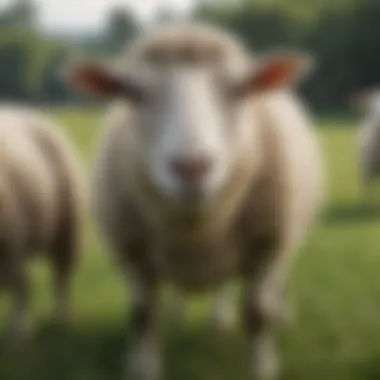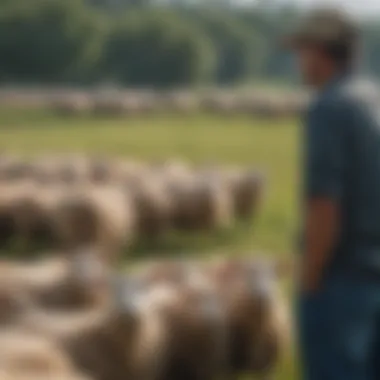Chlamydia Vaccine Development and Its Impact on Sheep


Intro
Chlamydia infections in sheep, notably caused by Chlamydia abortus, present significant concerns within the agricultural sector. The disease can lead to severe health implications, including reproductive failures such as abortions and stillbirths, which can result in economic losses for farmers. Addressing this issue, researchers have focused on the development of a vaccine that targets chlamydia in sheep. This article delves into the importance of such a vaccine by evaluating the current state of research, methodology used in vaccine development, and the broader implications—both health-related and economic—on livestock agriculture.
Key Findings
Major Results
Research indicates a growing recognition of chlamydia vaccines as viable options for reducing disease prevalence in sheep populations. Key studies reveal that immunization can significantly lower the rate of infections. Initial results from trials using recombinant proteins and inactivated whole cell vaccines show promise in eliciting a protective immune response among sheep. Further data demonstrates decreased incidence of reproductive issues in vaccinated flocks when compared to their unvaccinated counterparts.
Discussion of Findings
The implications of these findings extend beyond individual animal health. An effective chlamydia vaccine can lead to increased productivity within the sheep farming industry. Healthy sheep populations contribute to higher wool and meat yields, thereby benefitting farmers financially. The challenges, however, lie in gaining widespread acceptance of the vaccine among farmers and ensuring that it is economically feasible to implement. The research shows that effective educational initiatives can enhance understanding and acceptance of vaccination programs.
Methodology
Research Design
The methodological framework for vaccine development typically involves preclinical studies followed by phased clinical trials. This structured approach ensures that the vaccine is both safe and efficacious before it reaches the larger sheep population. The design integrates both laboratory testing and field studies, creating a comprehensive assessment environment.
Data Collection Methods
Data is collected through various means, including serological assays to measure immune response, monitoring of reproductive success rates, and overall health assessments in sheep post-vaccination. Field trials engage a range of farms to gather diverse data, ensuring that results are representative of different agricultural settings. Additional analyses, such as cost-benefit assessments, provide insight into the economic viability of vaccine implementation across the industry.
"The integration of cutting-edge research with practical application in agriculture remains vital for addressing livestock health issues."
Foreword to Chlamydia in Sheep
Chlamydia infections in sheep are of notable concern for both animal welfare and agricultural productivity. Understanding this pathogen is crucial for advancing veterinary medicine and livestock management. Chlamydia, a genus of bacteria, is known to cause significant disease in sheep populations, particularly leading to reproductive failures and associated economic losses. By exploring the fundamentals of Chlamydia as a pathogen, its prevalence in various sheep populations, and its symptoms and diagnostic methods, we can appreciate the pressing need for effective vaccination strategies.
Overview of Chlamydia as a Pathogen
Chlamydia species are obligate intracellular pathogens that can infect various hosts. Among sheep, Chlamydia abortus is particularly problematic, as it leads to enzootic abortion, a condition resulting in high rates of miscarriages in pregnant ewes. This specific strain not only affects individual animals but can also compromise the overall health of the flock, leading to substantial economic repercussions for farmers. It is important to recognize that the transmission of the pathogen often occurs in crowded or unsanitary living conditions, making it crucial for sheep producers to implement good management practices alongside health interventions. Studies suggest that understanding the biology and life cycle of Chlamydia can help in formulating effective control measures.
Prevalence of Chlamydia in Sheep Populations
The prevalence of Chlamydia infections in sheep varies geographically and is influenced by numerous factors, including flock management practices, climate, and the health status of the animals. Reports indicate that infection rates can be alarmingly high in some areas, sometimes exceeding 30% among breeding ewes. Regional studies suggest that sheep flocks in densely populated farming areas face greater risks of outbreaks. Furthermore, the seasonal fluctuations in birth rates and environmental challenges can exacerbate the spread of the disease. Understanding these trends is vital to mitigating the impacts of Chlamydia and ensuring the health of sheep populations.
Symptoms and Diagnosis of Chlamydia Infections
Recognizing the symptoms of Chlamydia infections is essential for timely intervention. Infected ewes often exhibit signs such as lethargy, fever, and vaginal discharge, which can lead to miscarriage or stillbirth if not addressed promptly. The diagnostic process often relies on clinical observation in conjunction with laboratory testing. Blood tests and polymerase chain reaction (PCR) assays are common techniques employed to confirm infections. However, many cases go undetected due to similarities with other conditions, which underscores the need for enhanced diagnostic protocols in sheep farming. Early detection not only helps in managing individual cases but also plays a critical role in controlling the spread within the flock.
"Chlamydia infections can devastate sheep populations, both from a health and economic perspective. Early intervention and a robust understanding of this pathogen are key to successful management."
The Role of Vaccination in Animal Health
The role of vaccination in animal health cannot be understated. Vaccines serve as powerful tools to prevent infectious diseases, significantly reducing morbidity and mortality rates across livestock populations. By stimulating the immune response, vaccines help animals develop immunity without undergoing the actual diseases. This is particularly relevant in sheep farming, where diseases like chlamydia can lead to severe health implications, affecting not just the individual sheep but also herd health and overall farm productivity.
Increased vaccination rates can mitigate disease outbreaks, ultimately fostering healthier livestock and maximizing economic returns for farmers. The implementation of vaccination programs can also lead to a decrease in reliance on antibiotics, addressing concerns about antimicrobial resistance, which is a growing issue in agriculture today.
Importance of Vaccination Strategies


Vaccination strategies are essential for effective disease management. Their successful implementation hinges on several factors:
- Timing and Scheduling: Proper timing for vaccinations can enhance their effectiveness. For chlamydia, understanding the at-risk periods for sheep populations aids in maximizing vaccine uptake.
- Types of Vaccines Used: Different vaccines serve specific needs, such as live attenuated vaccines or subunit vaccines. The choice of vaccine impacts the strength and duration of the immune response.
- Monitoring and Follow-Up: Evaluating the effectiveness of vaccination campaigns is critical. This may involve serological testing to determine the immune status of sheep following vaccination.
Strategies must also account for herd management practices. In some cases, targeted vaccination for high-risk groups, like pregnant ewes, becomes necessary to protect both the mothers and their offspring.
Challenges in Vaccinating Livestock
Vaccinating livestock presents unique challenges that can hinder the effectiveness of these programs. Some of the notable issues include:
- Access to Vaccination: Not all livestock producers have the same access to vaccines. Geographic location and economic factors can impact the availability of quality vaccines.
- Vaccine Hesitancy: Farmers may be skeptical about the efficacy or safety of vaccines. This hesitation is often influenced by misinformation or prior negative experiences.
- Logistics of Administration: Administering vaccines requires trained personnel to reduce the risk of improper handling or application. Additionally, the need for refrigeration and careful storage must be considered to maintain vaccine integrity.
- Costs: The financial implications of purchasing vaccines can be a barrier for many producers, especially in regions where profit margins are low.
Understanding these challenges is crucial for developing effective vaccination strategies. Policymakers and agricultural organizations need to collaborate, ensuring that farmers are educated and supported in their vaccination efforts.
"Vaccination holds the potential to transform animal health, but it demands comprehensive strategies backed by education and access."
The implications of these strategies extend beyond individual health, playing a significant role in maintaining the overall health of sheep populations and stability within the agricultural sector.
Development of the Chlamydia Vaccine
The development of a chlamydia vaccine for sheep is a critical area of research with vast implications for animal health and agriculture. Chlamydia poses significant health risks to sheep, leading to reproductive issues and decreased productivity. Thus, the advent of a vaccine can have profound benefits for both individual farmers and the broader sheep farming industry. Vaccination strategies not only aim to reduce the prevalence of the disease but also contribute to improved herd health and economic stability. The success of such a vaccine can facilitate healthier flocks, thereby enhancing the welfare of animals and increasing the profitability of the sheep farming sector.
Research Methodologies in Vaccine Development
The methodologies employed in the research and development of the chlamydia vaccine are diverse and rigorous. A multi-faceted approach is often required, encompassing fundamental laboratory research, field trials, and immunological analyses. Techniques such as reverse vaccinology and proteomics play an essential role in identifying potential antigens that can stimulate an immune response. Additionally, collaboration among various scientific disciplines is crucial to ensure a comprehensive understanding of both the pathogen and the host's immune response. Through these methodologies, researchers can assess the efficacy and safety of candidate vaccines before they advance to clinical trials.
Types of Vaccines Being Developed
Research in this area includes the exploration of several types of vaccines:
Live Attenuated Vaccines
Live attenuated vaccines consist of live pathogens that have been weakened so they cannot cause disease. This strategy can provoke a strong immune response due to the intact pathogenic structures. The benefit of live attenuated vaccines lies in their ability to elicit long-lasting immunity with a single dose. However, they also present challenges, especially in ensuring the stability and safety of the vaccine during production and storage. The potential for reversion to virulence, although rare, is a consideration that must not be overlooked when developing this type of vaccine.
Inactivated Vaccines
Inactivated vaccines are composed of pathogens that have been killed or inactivated through various methods, such as heat or chemical treatment. This type of vaccine is generally considered safer, as it cannot cause disease in the vaccinated animals. Inactivated vaccines may require multiple doses to achieve effective immunity, which could pose logistics challenges for farmers. They tend to have a more predictable safety profile, making them appealing for regulatory approval processes.
Subunit Vaccines
Subunit vaccines target specific components of the pathogen, such as proteins, to induce an immune response without using live or whole inactivated organisms. This can lead to fewer side effects and a more predictable immune response. One of the advantages of subunit vaccines is their strong safety profile. However, a significant challenge lies in identifying the right antigens to present to the immune system for a robust response. The potential for higher production costs associated with these vaccines also needs to be considered.
Preliminary Results from Clinical Trials
Preliminary results from clinical trials of the chlamydia vaccine have shown promise, indicating varying degrees of efficacy across different vaccine types. Early data suggest that each vaccine type has unique strengths, with live attenuated vaccines demonstrating strong immunity in initial trials, while inactivated and subunit vaccines have lower rates of adverse reactions. Researchers continue to explore the best combinations and dosages to maximize vaccine impact. Rigorous follow-up studies are essential to evaluate long-term immunity and effectiveness in larger populations. The ongoing analyses will ultimately shape how the final vaccine is formulated and approved.
Immunology Behind the Vaccine
Understanding the immunology behind the chlamydia vaccine for sheep is crucial. It helps us grasp how vaccines can effectively enhance the immune response of the host. In sheep, as in other animals, the immune system plays a pivotal role. It recognizes pathogens, initiates a response, and retains memory for future encounters.
How Vaccines Trigger an Immune Response


Vaccines work by mimicking an infection. When a sheep receives a vaccine, it is exposed to an antigen that resembles the pathogen causing chlamydia. This can be achieved in different ways, such as the use of inactivated or attenuated pathogens or specific proteins from the pathogen.
Once introduced, the immune system activates.
- Recognition: Antigen-presenting cells recognize the vaccine's antigen.
- Activation: This recognition stimulates T-cells and B-cells. T-cells assist in further activating other immune responses. B-cells will produce antibodies specific to the antigen.
- Memory Formation: After the vaccine has triggered a response, memory T and B-cells remain in the body. This allows for a more robust response upon future exposure to the real pathogen.
The result is a primed immune system, ready to neutralize the threat before it causes significant harm.
Evaluating Immunogenicity in Sheep
Evaluating immunogenicity is essential for determining how well the vaccine will work in sheep. Factors to consider include:
- Antibody Response: Measuring the levels of antibodies produced in response to the vaccine can indicate its effectiveness. Higher antibody titers generally suggest better protection.
- Cell-Mediated Immunity: In addition to antibodies, T-cell responses are crucial. Testing involves checking for activated T-cells after vaccination.
- Duration of Immunity: Understanding how long the immune response lasts can help in determining the vaccine's longevity.
Research methods such as ELISA for antibody detection and flow cytometry for T-cell activation provide insight into immunogenicity. It's important to ensure that the vaccine induces a strong and durable immune response to combat chlamydia effectively.
"Immunogenicity is not only about generating an immune response but about ensuring long-lasting protection against the disease."
Economic Considerations
Economic considerations play a critical role in understanding the implications of a chlamydia vaccine for sheep. An effective vaccine has the potential to significantly reduce disease prevalence, which can translate into improved health outcomes for sheep. This, in turn, can lead to better productivity for farmers. Key factors include the cost of developing and implementing the vaccine, as well as the economic benefits that successful vaccination can foster within the agricultural sector.
Cost-Benefit Analysis of Vaccination
When assessing the cost-benefit ratio of vaccination, several elements must be evaluated. The costs involved in developing the vaccine include research, clinical trials, manufacturing, and distribution. Farmers also incur expenses for vaccination programs, which include purchasing the vaccine and labor costs for administering it.
However, the economic benefits often outweigh these costs.
- Enhanced herd immunity can lead to reduced vet bills as fewer animals will require treatment.
- Increased wool and meat production, as healthier sheep yield higher quality products.
- Long-term stability in flock health, reducing financial fluctuations for farmers.
Studies suggest that investing in vaccination could return many times its initial cost once the benefits are realized. For instance, a successful vaccine could lead to fewer outbreaks and related economic losses, resulting in improved profitability for sheep farmers.
Impact on the Sheep Farming Industry
The introduction of a chlamydia vaccine stands to make a profound impact on the sheep farming industry. A healthier sheep population means farmers can operate more efficiently, reducing labor and resource costs while maximizing outputs. Furthermore, the economic ripple effect extends to related industries.
Vaccine implementation may foster:
- Increased demand for sheep products in both local and export markets.
- Improved sheep genetics and breeding programs, as healthier sheep lead to better offspring.
- Strengthened farmers’ market position, due to fewer disease outbreaks that could compromise product integrity.
- Enhanced consumer confidence in sheep products, benefiting sales in both traditional and organic markets.
In summary, the economic considerations surrounding the chlamydia vaccine for sheep highlight its importance in not only enhancing animal welfare but also promoting a more robust and resilient sheep farming industry.
Legislative and Ethical Implications
The discussion surrounding a chlamydia vaccine for sheep is not only rooted in scientific advancement but also deeply intertwined with legislative and ethical considerations. These implications are crucial because they shape how research is conducted, how vaccines are distributed, and how farmers adopt such interventions in their practices. Understanding this framework is essential for navigating the complexities that accompany vaccine development and application in livestock.
Regulatory Approval Processes for Veterinary Vaccines
The pathway to regulatory approval for veterinary vaccines is multifaceted and rigorous. It begins with comprehensive research, typically guided by national and international regulations. Before a vaccine can be administered to sheep, it must undergo several phases of testing. These include initial laboratory studies, followed by field trials which assess the vaccine's safety and efficacy in target populations.
In the United States, the process is primarily governed by the Animal and Plant Health Inspection Service (APHIS), part of the Department of Agriculture. They require that vaccines demonstrate both safety and effectiveness before they can be used commercially. This involves extensive documentation that outlines the methodology used during the development process, data on any adverse effects, and the results of efficacy trials.


The European Union also has a strict regulatory framework, emphasizing the importance of public health and animal welfare. The European Medicines Agency (EMA) oversees the approval of veterinary medicines and ensures each vaccine meets rigorous standards before it enters the market.
"Regulatory frameworks are crucial in ensuring that vaccines are safe for both animals and humans, reflecting the delicate balance of advancing agricultural practices while prioritizing safety and ethics."
Ethical Considerations in Vaccine Development
The ethical dimension of developing a chlamydia vaccine for sheep involves several layers. First, there is the concern regarding the treatment of the animals involved in testing. It is imperative that researchers adhere to principles of animal welfare, ensuring humane treatment throughout the research process. Ethical frameworks often mandate that animal testing should only occur when no alternative methods are available and that animals should not experience undue stress.
Equally important is the transparency of the vaccine development process. Ethical considerations extend to communicating potential risks and benefits effectively to stakeholders, including farmers, veterinarians, and the public. Producers need to understand how the vaccine could affect their livestock's health and agricultural productivity.
Moreover, there are broader societal implications. Vaccination can lead to a decrease in animal suffering, improved herd health, and enhanced productivity. However, it also raises questions about the accessibility of vaccines and the potential disparities in agricultural practices across different regions or between large producers and small farms.
Future Directions in Research
The pursuit of a chlamydia vaccine for sheep not only represents a significant advancement in veterinary medicine but also opens avenues for broader animal health initiatives. Research into this area holds implications that extend beyond a singular vaccine, reflecting the interconnected nature of animal health and agriculture. The advancement of vaccine technology can inform approaches to other infectious diseases, ultimately enhancing livestock wellbeing globally.
Potential for Broader Applications in Animal Health
The focus on a chlamydia vaccine provides a wealth of insights applicable across various types of livestock. As researchers develop and refine the methodologies used to create effective vaccines, similar strategies may be adapted for addressing other pathogens that affect sheep and other livestock species.
Some potential applications include:
- Integration into Multi-Disease Vaccines: The technology and strategies developed for the chlamydia vaccine could be utilized to create combination vaccines targeting multiple diseases, improving efficiency and reducing the number of injections that animals receive.
- Adaptation for Different Species: Lessons learned from the chlamydia vaccine development can be translated to vaccination programs for goats, cows, or even wildlife, where similar pathogens may be present.
"Developing versatile vaccine platforms ensures greater resilience in livestock health management."
These broader applications emphasize the importance of ongoing investigation in the chlamydia vaccine realm, as advancements may yield solutions for a spectrum of animal health challenges.
Collaborative Research Initiatives
Collaboration among scientists, veterinarians, and agricultural professionals is essential for successful vaccine development. By fostering interdisciplinary partnerships, researchers can harness collective knowledge to enhance the quality and efficacy of their studies.
Potential collaborative efforts could focus on:
- Shared Resources and Expertise: Universities, government institutions, and private corporations may partner in joint research projects, pooling financial resources, laboratory facilities, and intellectual expertise. This synergy is critical in navigating the complexities of vaccine development.
- Field Trials Across Different Environments: Encouraging collaboration with farmers and agricultural organizations can provide invaluable data from diverse environments. Field trials in varied conditions will help ensure that the vaccine is robust, adaptable, and effective in real-world settings.
- Cross-Species Research: Collaborating with researchers studying other animal health sciences can help identify common patterns of immune responses and vaccine efficiency, thus accelerating the development process for various livestock species.
In summary, the future directions in research surrounding the chlamydia vaccine for sheep could lead to innovative applications across animal health issues and bolster collaborative frameworks that enhance scientific progress. Such endeavors hold promise for not only improving the health of sheep but also contributing to the sustainability and productivity of the agricultural sector.
Culmination
The conclusion of this article serves as a vital synthesis of the key themes discussed throughout. It underscores the significance of developing a chlamydia vaccine for sheep, a step that could revolutionize sheep farming practices and promote animal welfare. The intricate relationship between disease management and economic viability in the agricultural sector highlights the need for innovation in veterinary medicine.
Summary of Key Findings
The research underscores several important findings:
- Prevalence of Chlamydia: The existence of chlamydia in sheep populations is not just a minor concern but a widespread issue that can lead to substantial health and economic repercussions.
- Vaccine Development: Various types of vaccines are in development, including live attenuated, inactivated, and subunit vaccines. Each type holds its own potential and challenges.
- Immunogenicity: Evaluating how effective these vaccines can trigger an immune response is critical to ensuring their success in sheep.
- Economic Impact: The cost-benefit analysis shows that while initial investment in vaccine development might be high, the long-term savings and benefits for farmers could be significant.
- Regulatory Frameworks: Navigating the regulatory landscape for new veterinary vaccines involves rigorous processes to ensure safety and efficacy, which are vital for public health and animal safety.
These findings reflect the multifaceted approach required for developing a successful chlamydia vaccine for sheep, emphasizing understanding disease dynamics, vaccine efficacy, and the economic implications for farmers.
Implications for the Future of Sheep Farming
The implications arising from the development of a chlamydia vaccine for sheep are profound. A successful vaccine can lead to numerous benefits:
- Enhanced Animal Health: Vaccinated sheep are less likely to suffer from chlamydia, leading to healthier livestock and reduced mortality rates.
- Economic Stability: Farmers could see a decrease in veterinary costs and an increase in productivity due to healthier flocks, thereby stabilizing their livelihoods.
- Consumer Confidence: Ensuring the health of the sheep population can reassure consumers regarding the safety of sheep products, enhancing market demand.
- Broader Applications: Insights gained from this vaccination process may lead to innovations in other areas of veterinary medicine, possibly extending beyond sheep to other livestock.
- Research Opportunities: The quest for a chlamydia vaccine opens doors for further research into vaccine development and disease control strategies in livestock.
In summary, the advancement of a chlamydia vaccine for sheep is not merely an academic exercise; it is a pivotal movement that stands to reshape the landscape of sheep farming and animal health. As research progresses, the convergence of scientific knowledge, economic viability, and regulatory frameworks will be essential to ensure the success of this initiative.



